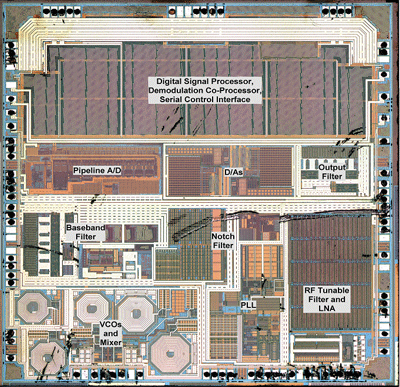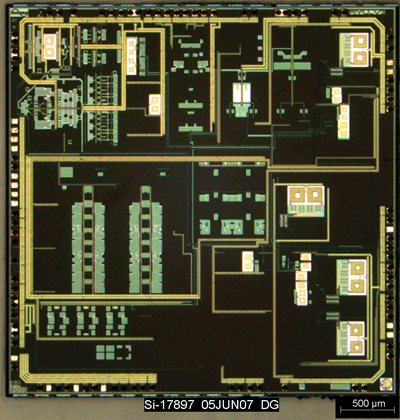Tag: TV tuner TV receiver
This article refers to the address: http://
Although mobile phones and wireless LAN transceiver silicon integrated circuits have changed many years ago, TV tuners using electric crystals have withdrawn from the starting line. Recently, several companies have begun to offer integrated circuit-based TV receivers that will replace traditional "tuners."
Over the past decade, we have witnessed significant technological innovations in TV products, high-definition digital TV, flat-panel TVs and stereo radios. In addition, Microsoft's Windows XP Media Center has created a thriving market for TV shows on PCs. In addition, there is an increasing demand for handheld mobile multimedia devices that allow consumers to watch live TV and download video. Enhancing these innovations in the conversion of broadcast television from analog to digital modulation is an imminent worldwide change.
The digital TV revolution is rapidly evolving; in fact, in some jurisdictions, analog broadcasting has stopped. However, in order to minimize the impact on the audience and promote a smooth transition, many governments have authorized analog (ie, NTSC, PAL, and SECAM) and digital (ie, DVB-T, ISDB-T, and ATSC standards) signals to coexist until February 17, 2009. Therefore, in many regions, the conversion of digital TV will span many years, and hybrid broadcasting systems will become an important market.
Interestingly, almost all analog TV remnants such as televisions and set-top boxes are still using low-level technology and "tuner" units, including hundreds of discrete components. A "tunable", called a good explanation: discrete fixed and adjustable inductors with individual transistors, have a large (often 2 x 4 inch) metal case to minimize RF interference. This manual requires that all of these individual components must be "tuned" resulting in a time consuming manufacturing and testing process.
Inkjet Receptive Coating, Anticorrosion Pigments, Matting Agent

The xc3028 microcontroller analog and digital TV tuner displays a fully integrated RF baseband function block mold annotation
It is clear that TV tuners using transistors can help solve these and other problems, including multiple standards, integration, volume and power consumption. In fact, we are still in the early stages, and IC TV tuners entering consumer electronics indicate that TV tuner design adaptations face greater challenges than cellular transceivers, for example, than cellular transceivers. So why can't we use a cellular network to make TV applications to mobile devices?
Tuner technical problem
The first technical difference to consider in tuner design is the bandwidth, interference, and dynamic range between mobile phone applications and broadcast television. The cellular receiver operates over a narrow frequency range. For example, a typical GSM receiver needs to receive 5 or 30 MHz, while a TV tuner must receive more than 800 MHz bandwidth (from 42 to 864 MHz).
The wide amplitude-frequency response affects the three elements of the receiver design: the frequency synthesizer, the low-noise amplifier module, and the filter. The main problem with the synthesizer is the ability to generate the required frequency and meet the lock time requirements while maintaining a small range of waveform factors and low power consumption. The main design focus is on the power amplifier blocks, which involve their susceptibility to a wide range of signals, which can lead to block images, artifacts and signal loss. These interfering signals may come from television broadcast stations, cellular transmissions, and even car engine ignition devices. Different cell phone receivers, using fixed filters in front of them, can effectively eliminate potential interference across a broad spectrum (due to the complexity of narrow frequency complexes), and TV receivers cannot use a single fixed filter to effectively reject interference. Signal because of the large broadcast bandwidth impact. Therefore, TV tuners require very specialized channel filtering techniques.

The highly integrated maxlinear mxl5005s analog and digital TV tuner provides a low-cost solution for receiving multiple points.
Another design hurdle is to design broadcast television signals that are adapted to large dynamic ranges. The arbitrariness of the receiver and the variable distance of the transmitter result in a wide variation in the signal strength of the channel. There is a need to deal with these potentially huge differences, and what is needed to handle these potentially large differences in the dynamic range is the very complex IC design. In fact, the cable's TV signal is exactly the same signal strength from channel to channel, allowing early integrated circuits to be deployed on cable TV receivers.
Due to this dynamic range problem, the tuner must be sensitive to very weak signals, including television signals coming in close to the receiver noise floor, even in the presence of strong interference. For example, an undesired signal strength can exceed the desired signal by up to 55 decibels, requiring the receiver to amplify the desired signal and present a more powerful interfering signal. Again, this is interfered by advanced channel filtering techniques.
An example of a silicon-based TV tuner for a set-top box is the xceive xc3028. It measures 4.2 x 4.3 mm which is manufactured by Jazz Semiconductor in a 5 metal layer, 0.18 μm BiCMOS process. It supports NTSC, PAL and SECAM analog standards. It also supports the ATSC, DVB-C, dvbt and ISDB-T digital standards by generating a digital demodulator interface signal and then processing additional digital demodulation circuits in a TV design. It also produces a low-power receiver IC that is especially suited for USB-based designs, adding TV functionality to desktop or notebook computers.
TV tuner for mobile devices
Multimedia features on mobile phones now include data, audio, video and real-time digital TV programming. Providing TV services to mobile phones is in two ways. First, the use of existing cellular networks, second, a dedicated one-way broadcast television network.
However, the method of television for low resolution and low frame rate cellular wireless communication systems is limited and may result in an action of stopping during transmission. More importantly, high-quality TV services require 10 times the data transfer rate of voice services. Therefore, if many users attempt to use the TV service at the same time, the demand will exceed the capabilities of the cellular network, resulting in a drop in the call or a "busy network" error message.
As a result, cellular networks have failed to provide customers with a range of TV services to all users, which means that TV broadcasts have better prospects for high performance and can provide real-time broadcast TV services to mobile phones. There are several competing standards including Digital Video Broadcasting - Handheld (DVB-H), Digital Multimedia Broadcasting (DMB), Integrated Services Digital Broadcasting (ISDB-T) and MediaFLO.
The ultra-low-power TV tuner for set-top boxes and mobile applications is the maxlinear mxl5005s global standard silicon tuner. It is 3.7 x 3.7mm in size, with five metal layers and a 0.18 micron CMOS process. With maximum line status, the unit consumes only 300 megawatts of energy and is suitable for analog and digital TV reception.
As a result of the integration, the next silicon tuner will likely incorporate a TV demodulator into the handheld application processor or be incorporated into the system package with the RF TV tuner. It is predicted that the next step will be the integration of the demodulator on the RF tuner die. However, with the standards of broadcasting, multimode and multituners will continue to evolve.